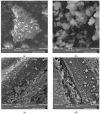Durability of Wood-Cement Composites with Modified Composition by Limestone and Stabilised Spruce Chips
- PMID: 39769898
- PMCID: PMC11677831
- DOI: 10.3390/ma17246300
Durability of Wood-Cement Composites with Modified Composition by Limestone and Stabilised Spruce Chips
Abstract
Limestone (LS) and stabilised secondary spruce chips (SCs) utilisation in wood-cement composites is still an unexplored area. Therefore, the main objective of the research presented here is the assessment of the long-term behaviour of cement-bonded particleboards (CBPs) modified by LS and SCs. Cement (CE) was replaced by 10% of LS, and spruce chips by 7% of SCs. The test specimens were stored in a laboratory and exterior environment (Middle Europe) for up to 2 years. The density, strength, and modulus of elasticity were evaluated after 28 days, and then in 6-month periods. The hygroscopicity was analysed separately. The mineralogical composition and microstructure were analysed due to possible LS participation during hydration. SC synergic behaviour in CBPs was also studied. After 2 years, the microstructure of the CBP was more compact, and denser. Strong carbonatation contributes to the improvement of CBP properties. The products of carbonatation were present in both the matrix and wood chips. The hydration of the matrix was almost finished. LS has a positive effect on the matrix microstructure development. LS acts both as an active component participating in the formation of the cement matrix structure and as an inert microfiller, synergic with hydration products. SCs have a positive effect on the hygroscopic behaviour of CBPs and slightly negative effect on the tensile strength.
Keywords: by-product; cuttings; limestone; long-term durability; mechanical properties; microstructure; particleboard; secondary spruce chips; stabilisation; wood–cement composite.
Conflict of interest statement
The authors declare no conflicts of interest.
Figures






















References
-
- Melichar T., Bydzovsky J., Dufka A. Long-term durability of cement-bonded particleboards with modified composition by waste dust. Waste Forum. 2021;2021:250–261.
-
- Sharma R.L., Pandey S.P. Influence of mineral additives on the hydration characteristics of ordinary Portland cement. Cem. Concr. Res. 1999;29:1525–1529. doi: 10.1016/S0008-8846(99)00104-0. - DOI
-
- Rahhal V., Talero R. Early hydration of portland cement with crystalline mineral additions. Cem. Concr. Res. 2005;35:1285–1291. doi: 10.1016/j.cemconres.2004.12.001. - DOI
-
- Lothenbach B., Le Saout G., Gallucci E., Scrivener K. Influence of limestone on the hydration of Portland cements. Cem. Concr. Res. 2008;38:848–860. doi: 10.1016/j.cemconres.2008.01.002. - DOI
Grants and funding
LinkOut - more resources
Full Text Sources

